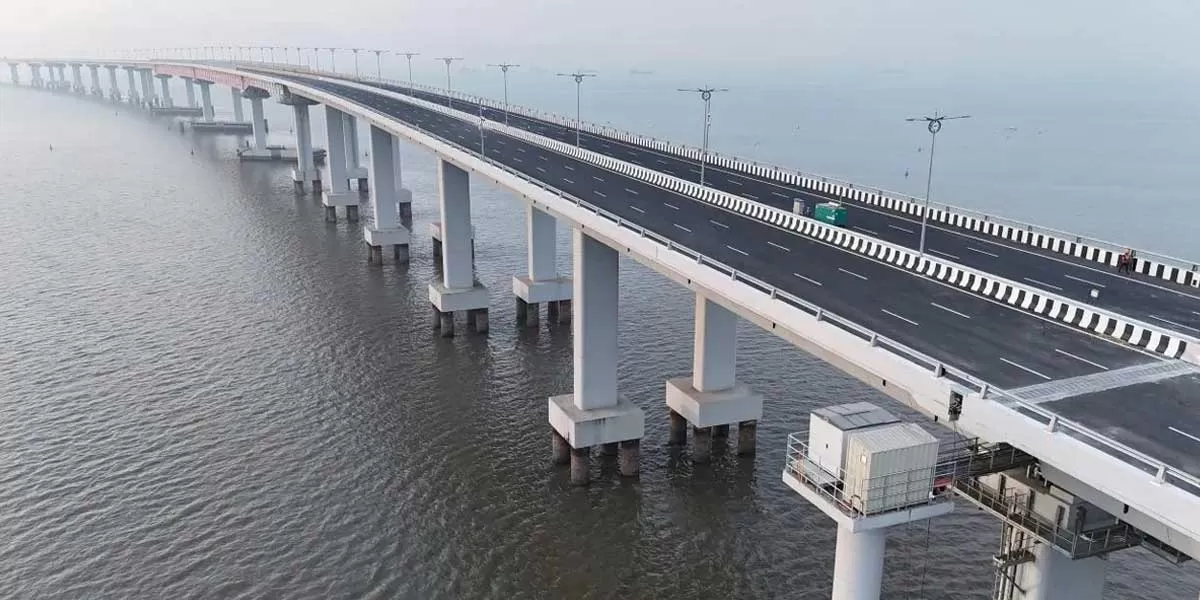The Mumbai Trans Harbour Link (MTHL) Atal Setu emerges as a groundbreaking feat in engineering, poised to transform Mumbai's transportation landscape. Spanning an impressive 22 kilometers, this monumental project, with a budget of INR
21,200 crores, exemplifies precision engineering, technological innovation, and a commitment to environmental sustainability.
Project Benefits:-
The MTHL Bridge gives a faster connectivity with proposed Navi Mumbai International Airport, JNPT Port, Mumbai – Pune Expressway and Mumbai – Goa Highway. On Mumbai side, Connectivity with Coastal road is planned through Sewri Worli Elevated Connector project.
Project Key Components:-
The total length of MTHL Bridge is 21.8 km in which length on sea is 16.50 km and on land portion is 5.5 km.
The sea link will contain a 6-lane (3+3 lane) highway+1emergency lane on both side.
There are 7 nos of OSD (Orthotropic steel Deck) spans of length 90m to 180m which are used on bridge first time in India.
There are Interchanges, at Sewri in Mumbai, Shivaji-Nagarand SH-54 in Jasai and at Chirle on NH-348.
The Project is being implemented using many unique products and state-of-the-art construction methods.
100 % work of erection of Orthotropic Steel Deck (OSD) is completed.
100 % work of concrete superstructure spans is completed.
Apart from the awe-inspiring sea bridge spanning across the Thane Creek, the project boasts several crucial components, including strategic interchanges that will seamlessly integrate the bridge with existing and upcoming infrastructure.
Interchanges - Weaving Mumbai's Traffic Fabric:
Sewri Interchange: Located on the Mumbai side, this interchange connects MTHL with the Eastern Freeway and Acharya Donde Marg, providing easy access to South Mumbai and the eastern suburbs.
Nhava Sheva Interchange: Situated on the Navi Mumbai
side, this interchange links MTHL with the NH-4B Panvel Highway and the proposed Mumbai-Goa Highway, opening up a direct route to Maharashtra's southern districts and Goa.
Chirle Interchange: This interchange near Chirle village
in Navi Mumbai connects MTHL with the Sion-Panvel Highway and the upcoming Navi Mumbai International Airport, offering convenient access to the airport and Navi Mumbai's central areas.
The MTHL project stands as a symbol of global collaboration, with a significant loan of INR 15,500 crores from the Japan International Cooperation Agency (JICA). This partnership emphasizes the shared commitment to advancing infrastructure and connectivity.
To translate this financial backing into tangible progress, the MTHL has been divided into three distinct packages, each focusing on a specific section of the bridge and its connecting roads. These packages are:
Package 1: Sewri side of the sea bridge (10.38 km) - Awarded to a consortium of Larsen & Toubro (L&T) and IHI Corporation (Japan). Contract signed in December 2017 for ₹7,637.3 crore.
Package 2: Navi Mumbai side of the sea bridge (7.807 km)
- Awarded to a joint venture of Daewoo Engineering & Construction (South Korea) and Tata Projects Limited (India). Contract signed later for ₹5,612.61 crore.
Package 3: Bridge portion on land towards Chirle (3.613 km) - Awarded to Larsen & Toubro (L&T). Contract signed in December 2017 for ₹1,013.79 crore.
Package 4: Smart Traffic Management System (STMS)- M/s.
STRABAG Infrastructure & Safety Solutions GmbH & STRABAG AG have been appointed for implementation of Package-4 (Rs. 427 Cr.)
One of the project's notable challenges involved navigating oil and gas pipelines submerged 10-15 meters underwater in Thane creek. The engineers undertook a sonar study and engaged divers to map the pipelines, ensuring the protection of critical assets.
Above water, the focus shifted to logistics and environmental considerations. Connecting MTHL from Sewri to the Eastern Freeway presented challenges such as limited space, poor road quality, and the presence of migratory flamingos. Special care was taken to minimize disturbance to the 2.25 Km eco-sensitive
site, leading to the innovative use of orthotropic steel decks and measures to reduce noise pollution.
The project's unique features extend to the substructure, where engineers employed innovative techniques for soil mapping and pillar stability. Soil investigations were conducted around every pillar, and drilling reached impressive depths, up to 45 meters towards the Sewri end and 36 meters on the Nhava Sheva end. Additionally, a temporary bridge facilitated construction activities while maintaining minimal environmental impact.
Environmental considerations extended to seismic resilience and weather durability. Despite Mumbai's low seismic risk, the MTHL is designed to withstand a magnitude of 7.5 on the Richter scale. Japanese technology, employing epoxy coating, enhances the bridge's durability by protecting against corrosion, chlorine penetration, and temperature-induced expansion and contraction.
The incorporation of Orthotropic Steel Decks (OSDs) showcases advanced technology, contributing to the bridge's strength and efficiency. The OSDs, with lengths up to 180 meters and weighing 2600MT, are a testament to cutting-edge manufacturing processes and stringent quality control.
As the MTHL Atal Setu nears completion, it anticipates accommodating a daily traffic influx of 70,000 vehicles. Spearheaded by the Mumbai Metropolitan Region Development Authority (MMRDA) since 2018, the project not only promises enhanced transportation but also catalyzes real estate development in Navi Mumbai.
In essence, the MTHL Atal Setu transcends traditional infrastructure projects, embodying technological prowess, environmental consciousness, and strategic global partnerships. As it prepares to link Mumbai's shores, this architectural marvel leaves an indelible mark on the city's skyline, heralding a future characterized by seamless
connectivity and sustainable progress.
To read the full story, CLICK HERE.


















